The Huawei MateBook X Pro Review: Calling Out The Competition
by Brett Howse on June 27, 2018 8:00 AM ESTDisplay Performance
Huawei has outfitted the MateBook X Pro with a 3000 x 2000 resolution IPS display featuring low-temperature polycrystalline silicon to provide better power consumption. The 3:2 aspect ratio matches what Microsoft started offering, along with the same resolution as offered in the Surface Book 13.5, but this is a 13.9-inch display so it’s a bit larger, but still offers a solid 260 pixels per inch. Huawei has stated the display covers 100% of the sRGB gamut, and offers 1500:1 contrast along with 450 nits brightness, so we’ll see how well they do there.
The move to 3:2 is something all notebooks should look into, because for most use cases, the extra vertical resolution is very beneficial when doing almost any task, with the exception of TV and movies, which are 16:9 or wider. The aspect ratio is a great compromise between widescreen and the older 4:3 though.
So without further ado, let’s dig into the display performance. We measure displays at 200 nits brightness using SpectraCal’s CalMAN suite with a custom workflow. Contrast and brightness measurements are done with an X-Rite i1DisplayPro colorimeter, and color accuracy is tested with an X-Rite i1Pro2 spectrophotometer.
Brightness and Contrast
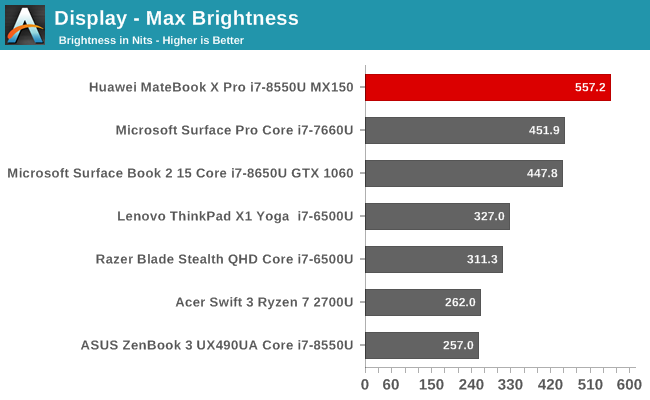
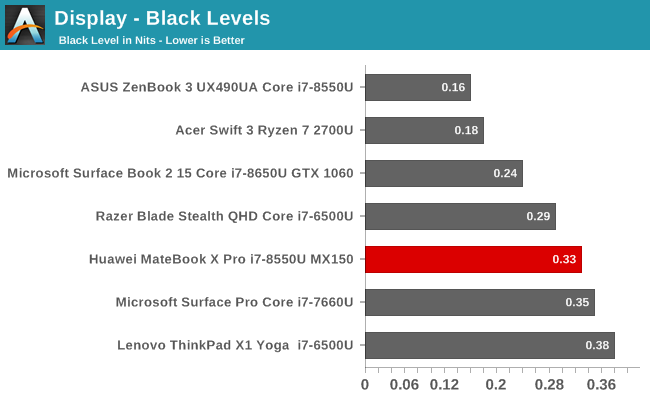
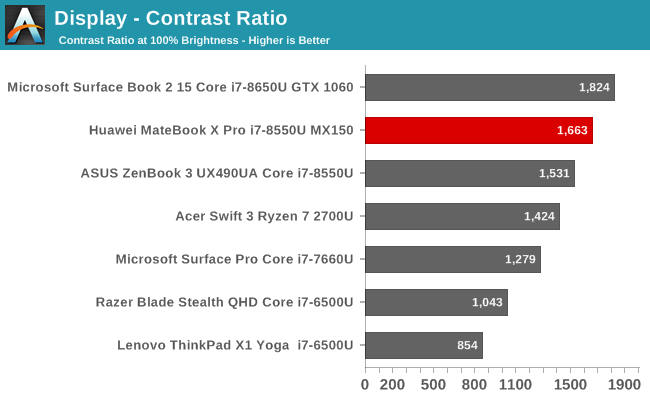
Huawei has certainly delivered on some of their claims. The MateBook X Pro review unit achieved an eye-searing 557 nits maximum brightness, but at the same time offered great black levels, with contrast well over their 1500:1 target. Every device is going to be somewhat different, but it’s great to see this unit well over their goals. With such a high brightness, the MateBook X Pro should be fairly usable outdoors as well.
Grayscale
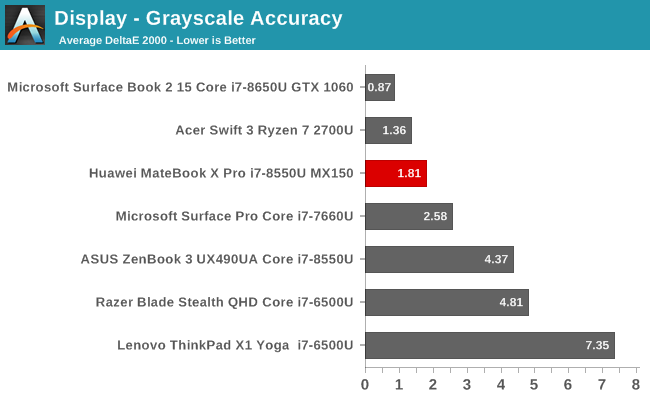
Huawei has done a very solid job at the factory with this display, with a grayscale average error level of only 1.8, and with no tested points even going over an error level of 2.5. The primary colors are also pretty solid, with blue being a bit too high but only slightly. By default the gamma is a bit too low as well coming in at an average of 2.05, with a big drop near 100% brightness. Still, it’s a very good start.
Gamut
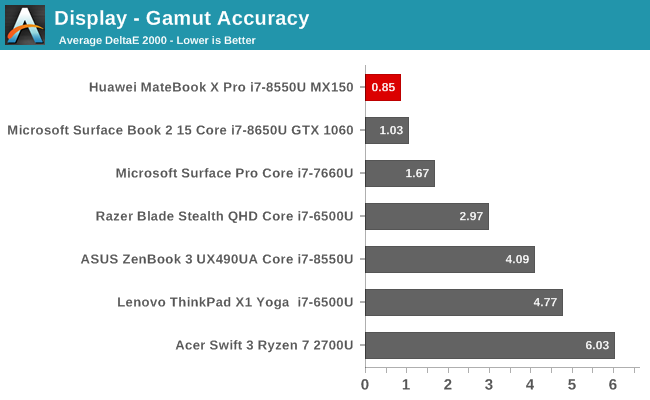
Once again this display performs very well, covering almost the entire sRGB gamut with igh levels of accuracy. The blue is only slightly under where it should be at 100%, but the overall dE2000 is a mere 0.85 which is fantastic.
Saturation
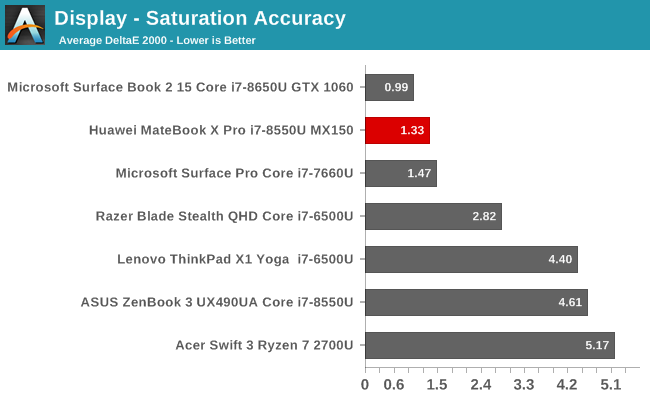
Whereas the Gamut test only does the 100% levels for the primary and secondary colors, the saturation sweep tests the entire range in 4-bit steps to make sure there’s not deviation anywhere on the range, and the MateBook X performs admirably here as well, with one of the best error levels we’ve seen.
Gretag Macbeth
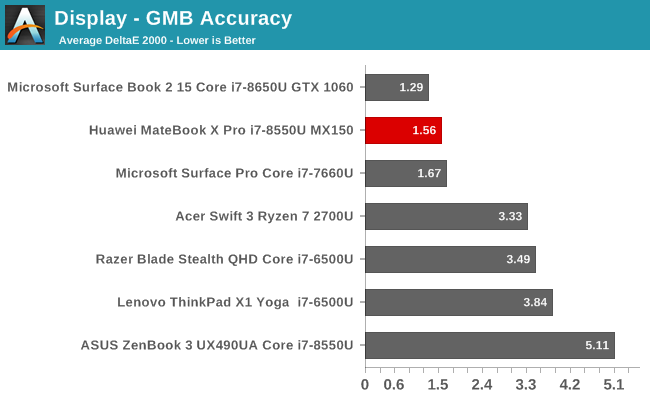
This final test moves off of just testing the primary and secondary colors, and tests important colors such as skin tones. Once again the MateBook X Pro provides a great result, with none of the individual colors even having an error level over 3.0, with almost all of them well under the 2.0 level.
Colorchecker
Here’s a sample image of the relative color errors on this display, with the bottom half of the image showing the target color, and the top half of the image showing the display output. Please note this is a relative test though because any errors in your own display will vary both the target and output.
The MateBook X Pro offers almost perfect color accuracy, and clearly Huawei has taken the extra time and cost to color calibrate the displays at the factory. For most people, the level of error is small enough that you’d never notice it unless you were doing color critical work.
Display Conclusion
What’s not to like about the MateBook X Pro’s display? It’s a high resolution display with a great aspect ratio for working. It offers incredible brightness, great contrast, and Huawei has color calibrated it to the sRGB gamut almost perfectly. There’s not much else to say other than this is a fantastic display.















77 Comments
View All Comments
iwod - Wednesday, June 27, 2018 - link
A Macbook Pro 13", with a less resolution Retina Screen, Dual Core, but same memory and SSD, cost $1499. However it is the higher end that is embarrassing, with 512GB SSD, 16GB, still dual core, and Retina Screen, no Geforce MX cost $2199!!peevee - Wednesday, June 27, 2018 - link
"It’s a full six-row keyboard though, and other than the webcam being on the top row, it’s all well thought out."Really? Where are Insert, Home, Page Up, Page Down and End keys then?
Brett Howse - Wednesday, June 27, 2018 - link
They are Fn keys like most laptopstipoo - Wednesday, June 27, 2018 - link
Pleased to see this review here!tipoo - Wednesday, June 27, 2018 - link
The impressive thing here is that Swift 3 with the Ryzen 2700U sticking so close to the MX150 on GPU performance. It may be in the article but what wattage is the 150 running at?Brett Howse - Wednesday, June 27, 2018 - link
Nvidia doesn't say TDP values for their laptop parts. I'd guess it's about 15WJon Tseng - Wednesday, June 27, 2018 - link
Might be worth checking - I think there's been some issues w MX150s being power restricted (effectively turned into max-q parts) on some thin n lights. So in real world terms there are effectively two variants of mx150 our there. I would assume this is downclocked given the obvious thermal constraints of that design but I could be wrong.Brett Howse - Wednesday, June 27, 2018 - link
Thanks for that info. Got to love the recent naming conventions by team green :)This is the lower power version with the max boost around 1030 MHz. I'll make a note in the review.
Brett Howse - Wednesday, June 27, 2018 - link
Apparently we even wrote about this:https://www.anandtech.com/show/12565/nvidia-silent...
skavi - Thursday, June 28, 2018 - link
Is it also possible that the MX150 is only using 2 PCIe lanes? It would be great If you could check how the lanes are distributed between the GPU, Thunderbolt controller, and SSD.(You can check this through HWiNFO btw)